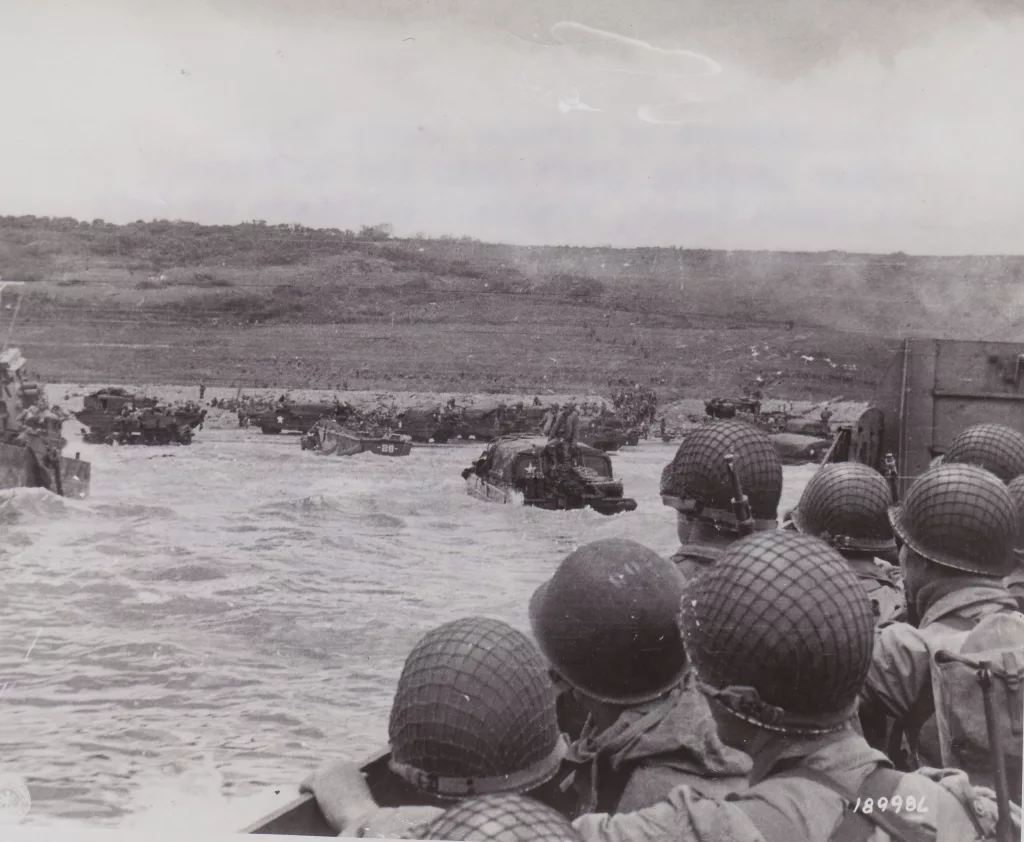
by Mike Blagg
June 6, 1944. D-Day. The day the tide turned against Germany in World War II.
World War II was the biggest war in history. In some ways it was an extension of World War I, an Act 2, so to speak. World War I was a military stalemate for several years, but finally ended in November 1919, when the German economy and government collapsed. The victors — primarily England, France, and the United States — imposed harsh sanctions on Germany in the peace treaty. Sanctions that made the economy in Germany even worse, and created in Germany mistrust and hatred of the victorious nations.
In the 1920’s a man named Adolph Hitler came along with his National Socialist Party and tapped into that mistrust and hatred to accumulate political power for himself and the Nazis. In January 1933 he was named Chancellor of Germany. He began building the Third Reich, or Third Empire, of Germany, an empire that was planned to last 1,000 years and dominate the world. He quickly overtook Austria and Czechoslovakia. British Prime Minister Neville Chamberlain met with Hitler in Munich, Germany in September 1938 and came home with a peace agreement, in which Hitler promised to stop right there and expand no more. It didn’t work.
World War II officially began on September 1, 1939, when Germany invaded Poland. In the spring of 1940 Hitler had his army move west, and overtook the Netherlands, Belgium, and France by May 1940. He wanted to invade England, but was repelled by the Royal Air Force in the Battle of Britain, which lasted several months in the summer of 1940.
Germany had a peace treaty with the Soviet Union, but in June 1941 Hitler ignored that and had his army move east into the U.S.S.R. (Russia). The German armies got almost to Moscow and Stalingrad before they were defeated and began retreating.
Meanwhile, Hitler and the Nazis built a network of concentration camps, dozens of them, where they imprisoned political enemies and Jews. Mostly Jews. Camps such as Dachau, Auschwitz, and Buchenwald. Hitler blamed the Jews for just about all of Germany’s problems. Over the course of the war about one million Jews and other prisoners were killed in the concentration camps. Many were killed in gas chambers. Others were shot, hanged, worked to death or starved to death.
Hitler and the Nazis had to be stopped. The failure to invade England was huge. It gave the Allies a base to fight back from. The English and Americans began bombing Germany with airplanes flying from airfields in England. They did a lot of damage in Germany, but that was not enough to win the war. The European continent, and Germany, would have to be invaded.
The invasion was known as Operation Overlord, and was in the planning stage for years. In December 1943 American General Dwight D. Eisenhower was named Supreme Commander of Allied forces. He was now in charge of the invasion.
D-Day was originally planned for June 5, 1944, but bad weather postponed the invasion one day to June 6. Shortly after midnight on that day paratroopers landed in France. At 6:30 a.m. naval and aerial bombardment of the German defenses began. Then the ships with the invasion soldiers came to the beaches of Normandy, France. Lots of soldiers — 160,000 — from America, England, and Canada. The invasion included 5,000 ships and 11,000 aircraft. It was difficult, some 4,000 Allied soldiers lost their lives that day, but the invasion was successful. The Allied soldiers established a presence on the mainland of Europe. It was the largest naval, air, and land military operation in history.
Through a clever misinformation program involving double-agent spies, the Allies had convinced Germany that the invasion would take place farther north, at Pas-de-Calais. The Germans held troops back to protect that area, or the invasion at Normandy would have been much more difficult.
Within a few days the Allies had landed more than 300,000 troops in France, along with 50,000 vehicles and 100,000 tons of equipment. By August 1944 all of northern France was liberated. The armies continued their push toward Germany. Meanwhile the Russians were moving in from the east. All the armies from east and west converged in Germany in the spring of 1945. Adolph Hitler committed suicide on April 30. Germany surrendered and V-E Day (Victory in Europe) was declared on May 8, 1945.
D-Day was the beginning of the end for Adolph Hitler, the Nazi Party, and tyranny. Never forget the men and women who were a part of D-Day. They helped to save the world.
(Photo above courtesy of the National World War II Museum)